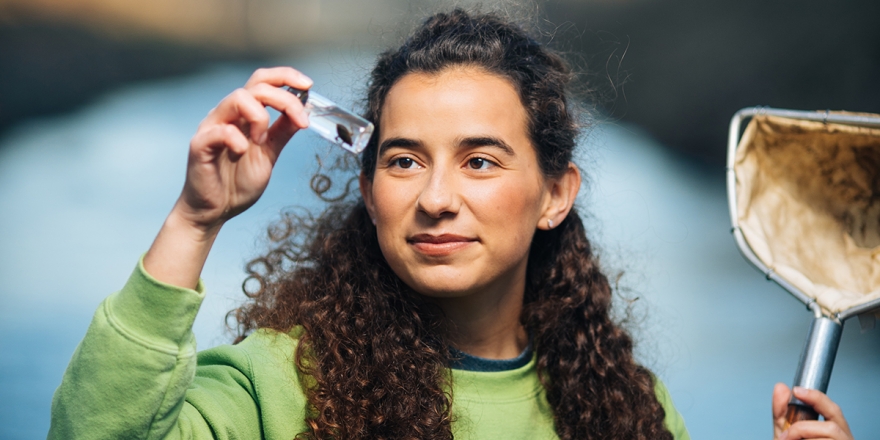
Netting Knowledge in CSM’s Immersive Environmental Biology Class
What comes to mind when you read the class listing “BIO 268/269 - Environmental Biology”? Dry textbooks? Drawn-out lectures? Maybe some statistics on pollution?
Think again. It’s much more alive for students at College of Saint Mary.
For Mike Kaminski’s environmental biology class, it means reaching into streams, wrangling fish, and examining freshly caught insects.
“I love going to sample in the creek,” says Allyah Rayyan ’19, a biology major. “Learning about what is in the water is one thing, but actually getting into the water and seeing it first-hand is an amazing opportunity.”
In Kaminski’s environmental biology class, students study the basic principles of biology by examining populations, communities, and ecosystems. But rather than just reading about theories from the confines of a classroom, students are getting their hands dirty and going out into the nature they’re studying. In the class, students learn first-hand how those principles relate to water quality, biodiversity, sustainability, climate change, and other threats to the planet.
Along with learning fundamentals inside the classroom, students trek into nature to test pollution levels and analyze local ecosystems. One popular activity includes walking to Little Papillion Creek east of campus to catch fish and aquatic insects and collecting data to determine the ‘health’ of the stream.
Students use seine nets to catch fish and kick nets to collect insects and other invertebrates. Fish are sorted by species, enumerated, and promptly returned to the stream, while small invertebrates are identified and counted in the laboratory. By counting and comparing different species, they learn to measure the overall pollution and health of local ecosystems.
“This method is an inexpensive and relatively easy way to assess impacts of water pollution,” says Kaminski. “It’s a fairly accurate indicator of the effects of pollution on aquatic organisms and can be used to monitor conditions over time in the same stream or to compare one stream with another”.
This on-site approach includes dry land, too. Students visit the local recyclable waste processing center to see how curbside recycling works, and the sewage treatment plant to understand what has to happen before water leaving the bathroom drain can reenter the Missouri River.
Overall, Kaminski says the class is built to keep students engaged, but it also helps students connect with environmental issues on a personal level – a level that encourages them to boldly apply concepts to their own lives.
“It’s important for them to be outdoors and visit sites to see first-hand many of the topics that we cover in lecture,” Kaminski says. “There’s also value to conducting experiments in the lab which they can replicate and hopefully pass on to the next generation. These types of experiences are impactful and it gets them to think deeper about their role as stewards of the planet and about the future.”

For Rayyan, the class and other active learning opportunities at CSM have shown her how much she enjoys studying living organisms – even if it means getting a bit wet in the process.
“Every time I have gone into the creek, even when I have fallen in, I learn something new,” says Rayyan. “If it weren’t for the classes I have taken at CSM that go on mini-adventures like this one, I would never have learned how much I enjoy the process of collecting samples.”
Rayyan points out that CSM’s campus has a special advantage when it comes to studying local ecosystems. In addition to being part of a larger system of Omaha running trails and parks that go through the metro area, Little Papillion Creek runs along the edge of campus. This is where the class can conveniently access what is essentially an outdoor laboratory.
Despite being home to a variety of life, the local creek gives students a realistic view on the impact humans have on nature, Kaminski says.
“[At Little Papillion Creek] we can demonstrate things like stormwater runoff and how it carries sediment and other pollutants from bare soil, pavement, lawns, and other sources from throughout the watershed,” Kaminski says.
Whether it’s through collecting data in the field or conducting in-lab glacier melting simulations, the class is helping students understand the importance of paying attention to environmental issues. Still, it’s going much deeper than raising awareness. Students are also learning how to examine nature, gather credible information, and take action.
“I try to stress the importance of being perceptive about what’s going on in the world around them,” Kaminski says. “But, as important as it is for students to be aware of what’s happening on our planet, it’s equally important that they understand why. That’s where this class comes in.”

As much as the course dives into biological systems, it’s also resonating with CSM students outside of the biology major. Alycia Ervin ‘21 is an elementary education major. As someone who has long been passionate about helping others and leading positive change, she says the class is giving her the knowledge to carry out that mission.
“I’ve always wanted to make a difference,” says Ervin. “That’s a big reason I chose elementary education. Someday my students may want to make a difference themselves and change the world in their own way.”
As they enjoy wading through creeks, examining insects, and handling fish, Ervin, Rayyan, and the rest of the class are getting an up-close look at a world many take for granted. At the same time, the class is inspiring leadership and equipping tomorrow’s leaders to change the world for the better.
“The class always has a lecture about the problems in the world, and then at the end of class, we talk about the best way to go about protecting and preserving the planet we all live on,” notes Rayyan.
“This course applies to everyone because it talks about what we can do to help the Earth and leave behind something wonderful for the next generation.”
CSM’s environmental biology course is open to students of all majors. Although the 2019 course wrapped up in December, the university plans to continue new offerings of the class in the future.











